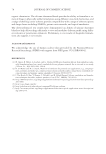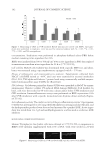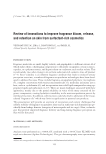JOURNAL OF COSMETIC SCIENCE 98 REFERENCES (1) S. X. Lu, The science behind transfer-resistant color cosmetics, a podium presentation at Society of Cosmetic Chemists’ 69th Annual Scientifi c Meeting (2014). (2) R. Lockhead and M. Lockhead, Two decades of transfer-resistant lipstick, Cosm. & Toil., 130, 18–29 (2015). (3) P. Tsolis and J. Castro, Stability, Uniformity in Foundations, Cosm. & Toil., XX, XX–XX (2012). (4) Z. Li, et al, A set of non-human test methods for comprehensive understanding of color cosmetics’ se- bum resistance, a podium presentation at Society of Cosmetic Chemists’ 70th Annual Scientifi c Meeting (2015). (5) H. Brieva, J. G. Russ, and I. M. Sandewicz, Cosmetic compositions, US Patent 5800816 (1998). (6) A. Patil, J. Calello, R. Sandewicz, Cosmetic compositions with silicone resin polymers, US Patent 20080050328 (2008). (7) L. E. Drechsler, T. E. Rabe, and E. D. Smith, III, Transfer resistant cosmetic compositions, US Patent 6406683 (2002). (8) S. X. Lu, W. Yu, and X. Blin, Cosmetic compositions comprising at least one polysiloxane based poly- amide. US Patent 6958155 (2005). (9) D. Luo, H. Brieva, M. Susak, T. Wang, W. Mu, S. Nazar, and W. A. Lee, Transfer resistant cosmetic, US Patent 7261877 (2002).
J. Cosmet. Sci., 68, 99–106 ( January/February 2017) 99 New nature-inspired urocanic acid mimic preventing DNA damages and immunosuppressive signalling induced by ultraviolet-B radiations M. MOLLET, P. LAFITTE, B. MORAND, T. HOARAU, P. PIOT, A. L. THOMAS, M. FRÉCHET, and J-F. NICOLAŸ, Exsymol S.A.M., Monaco, Principality of Monaco. INTRODUCTION Ultraviolet-B (UVB) absorption by endogenous chromophores such as DNA, tryptophan, or urocanic acid (UCA) initiates mechanisms responsible for the adverse effects of this radiation (local immune suppression and cancer induction, premature aging, infl amma- tion, cell death, etc.). Therefore, the use of exogenous UV-absorbing substances (sun fi l- ters) to avoid absorption by endogenous chromophores is a regular and effective strategy for photoprotection of the skin. However, regulatory constraints and inherent limitations of sun fi lters (solubility, lack of photostability, side effects, etc.) call for the design of ef- fective, stable, and well-tolerated additives. In the course of our investigations on secondary metabolites found in some tropical plants, we have identifi ed a powerful UVB-absorbing cis-methylthiopropenoïc acid conjugate (MTPC) (Figure 1). MTPC shares with UCA, a “natural sunscreen” produced in the most superfi cial layers of the epidermis, the ability to release absorbed photons energy by a mechanism of trans to cis isomerisation (Figure 1). This is a “nonsacrifi cial” absorption mechanism (MTPC isomer also absorbs UVB to form the original isomer again) that prevents photodegradation. MT PC is also endowed with some antioxidant properties, due to the presence of a conju- gated thio-ether moiety (Figure 1), and interestingly, some anti-infl ammatory properties had been reported for the natural trans isomer (1). Therefore, we investigated MTPC photoprotective properties with biochemical and close-to-reality in vitro models. Empha- sis was placed on UVB-induced immunosuppression as UVB absorption (preventing UCA isomerisation into the immunosuppressive cis UCA, Figure 2A), antioxidation (scavenging of ROS involved in the immunosuppressive signalling, Figure 2B), preven- tion of DNA damages (Figure 2C), and anti-infl ammatory properties [tumor necrosis Address all correspondence to Jean François Nicolay at jfnicolay@exsymol.com.
Purchased for the exclusive use of nofirst nolast (unknown) From: SCC Media Library & Resource Center (library.scconline.org)












































































































































